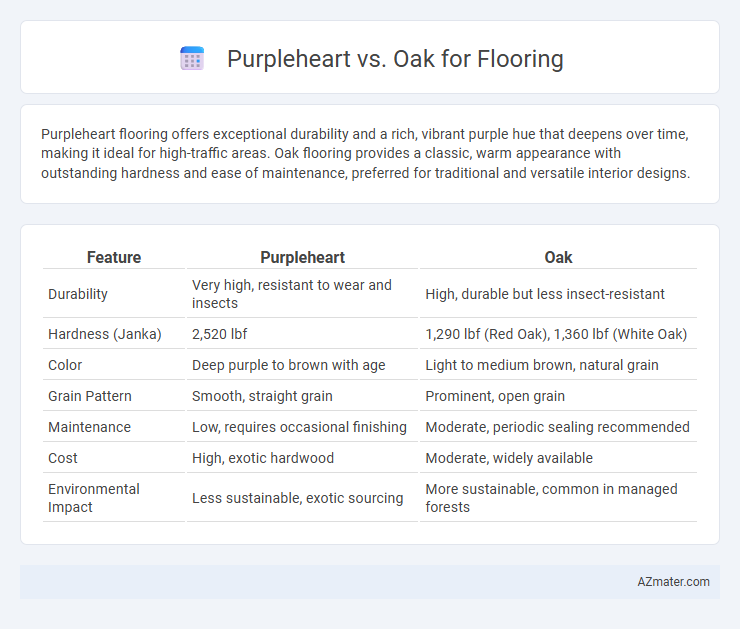Purpleheart flooring offers exceptional durability and a rich, vibrant purple hue that deepens over time, making it ideal for high-traffic areas. Oak flooring provides a classic, warm appearance with outstanding hardness and ease of maintenance, preferred for traditional and versatile interior designs.
Table of Comparison
| Feature | Purpleheart | Oak |
|---|---|---|
| Durability | Very high, resistant to wear and insects | High, durable but less insect-resistant |
| Hardness (Janka) | 2,520 lbf | 1,290 lbf (Red Oak), 1,360 lbf (White Oak) |
| Color | Deep purple to brown with age | Light to medium brown, natural grain |
| Grain Pattern | Smooth, straight grain | Prominent, open grain |
| Maintenance | Low, requires occasional finishing | Moderate, periodic sealing recommended |
| Cost | High, exotic hardwood | Moderate, widely available |
| Environmental Impact | Less sustainable, exotic sourcing | More sustainable, common in managed forests |
Introduction to Purpleheart and Oak Flooring
Purpleheart flooring, derived from the dense hardwood of the Peltogyne tree native to Central and South America, showcases a rich, vibrant purple hue that deepens over time, offering a unique and exotic aesthetic. Oak flooring, sourced primarily from the widely available Quercus species in North America and Europe, is celebrated for its classic grain patterns, durability, and versatility in various interior styles. Both options provide robust hardness and longevity, with purpleheart standing out for its striking color and oak favored for its timeless appeal and ease of maintenance.
Key Characteristics of Purpleheart Wood
Purpleheart wood, known for its striking deep purple hue that darkens to a rich brown with age, offers exceptional durability and resistance to wear, making it ideal for high-traffic flooring. Its dense grain and natural oils provide outstanding resistance to rot and insect damage, surpassing many traditional hardwoods like oak in longevity. The vibrant color and hardness of Purpleheart create a unique, eye-catching floor that balances aesthetic appeal with robust performance.
Key Characteristics of Oak Wood
Oak wood, known for its durability and strength, features a prominent grain pattern with a warm, light to medium brown color that darkens over time. Its high density and resistance to wear make it ideal for high-traffic flooring areas, providing long-lasting performance and stability. Oak's natural tannins contribute to its resistance to insect and fungal attacks, ensuring longevity in various environments.
Durability and Hardness Comparison
Purpleheart flooring offers exceptional durability with a Janka hardness rating of approximately 2,520, making it significantly harder and more resistant to scratches and dents compared to Oak, which typically ranges between 1,200 and 1,360 on the Janka scale. Its dense, interlocking grain structure enhances its toughness and longevity in high-traffic areas, whereas Oak's moderately hard texture can show wear over time under heavy use. Both woods provide stable flooring options, but Purpleheart's superior hardness ensures a longer lifespan and better performance in demanding environments.
Visual Appeal and Color Differences
Purpleheart flooring showcases a striking, vibrant purple hue that deepens to a rich brownish-purple over time, creating a bold, exotic visual appeal ideal for accent floors or unique design statements. Oak flooring offers a classic, warm aesthetic with its light to medium brown tones and prominent grain patterns, providing versatile appeal suitable for traditional and contemporary interiors. The stark contrast between Purpleheart's dramatic color and Oak's subtle earth tones makes each wood choice distinctly suited to different design preferences and styles.
Maintenance and Care Requirements
Purpleheart flooring requires less frequent refinishing due to its high density and natural resistance to dents and scratches, making maintenance relatively low-effort. Oak flooring demands more regular sealing and can show wear more readily, necessitating periodic sanding and refinishing to maintain its appearance. Both hardwoods benefit from routine cleaning with pH-neutral products and controlled indoor humidity to preserve their structural integrity and finish longevity.
Cost Comparison: Purpleheart vs Oak
Purpleheart flooring typically costs between $10 and $15 per square foot, making it a mid-to-high priced hardwood option compared to oak, which ranges from $3 to $10 per square foot depending on the species and grade. Installation and finishing expenses for Purpleheart tend to be slightly higher due to its density and hardness, which can require specialized tools and labor. Overall, oak is generally more cost-effective for budget-conscious projects, while Purpleheart offers a unique aesthetic that justifies its premium price for many homeowners.
Environmental Impact and Sustainability
Purpleheart flooring offers durability and a rich purple hue while being sourced from sustainably managed rainforests, contributing positively to environmental conservation when certified. Oak flooring, commonly harvested from temperate forests with established replanting programs, provides a balance between availability and ecological responsibility, often featuring FSC certification to ensure sustainable forestry practices. Choosing wood with certifications like FSC or PEFC ensures reduced deforestation and supports responsible forest management, making sustainability a critical factor in both Purpleheart and Oak flooring options.
Best Applications for Each Wood Type
Purpleheart's rich purple hue and extreme durability make it ideal for high-traffic areas such as hallways and commercial spaces where visual impact and wear resistance are crucial. Oak's classic grain patterns and moderate hardness suit living rooms, bedrooms, and traditional homes, providing a warm, timeless aesthetic with easier refinishing potential. For eco-conscious projects, oak's wider availability and sustainable sourcing options often make it the preferred choice.
Conclusion: Which Wood is Better for Your Flooring?
Purpleheart offers exceptional durability and a distinctive deep purple hue that ages beautifully, making it ideal for high-traffic areas where bold aesthetics are desired. Oak provides versatile grain patterns, reliable hardness, and easier maintenance, suited for traditional or rustic floor designs with long-term value. Choosing between Purpleheart and Oak depends on whether you prioritize unique color and wear resistance or classic appearance and low upkeep.

Infographic: Purpleheart vs Oak for Flooring
 azmater.com
azmater.com